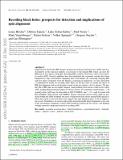Recoiling black holes: prospects for detection and implications of spin alignment
Author(s)
Blecha, Laura; Sijacki, Debora; Kelley, Luke Zoltan; Torrey, Paul; Vogelsberger, Mark; Nelson, Dylan; Springel, Volker; Snyder, Gregory; Hernquist, Lars; Torrey, Paul A.; ... Show more Show less
DownloadRecoiling black holes.pdf (1.768Mb)
OPEN_ACCESS_POLICY
Open Access Policy
Creative Commons Attribution-Noncommercial-Share Alike
Terms of use
Metadata
Show full item recordAbstract
Supermassive black hole (BH) mergers produce powerful gravitational wave emission. Asymmetry in this emission imparts a recoil kick to the merged BH, which can eject the BH from its host galaxy altogether. Recoiling BHs could be observed as offset active galactic nuclei (AGN). Several candidates have been identified, but systematic searches have been hampered by large uncertainties regarding their observability. By extracting merging BHs and host galaxy properties from the Illustris cosmological simulations, we have developed a comprehensive model for recoiling AGN. Here, for the first time, we model the effects of BH spin alignment and recoil dynamics based on the gas richness of host galaxies. We predict that if BH spins are not highly aligned, seeing-limited observations could resolve offset AGN, making them promising targets for all-sky surveys. For randomly oriented spins, ≲ 10 spatially offset AGN may be detectable in Hubble Space Telescope-Cosmological Evolution Survey, and >10³ could be found with the Panoramic Survey Telescope & Rapid Response System (Pan-STARRS), the Large Synoptic Survey Telescope (LSST), Euclid, and the Wide-Field Infrared Survey Telescope (WFIRST). Nearly a thousand velocity offset AGN are predicted within the Sloan Digital Sky Survey (SDSS) footprint; the rarity of large broad-line offsets among SDSS quasars is likely due in part to selection effects but suggests that spin alignment plays a role in suppressing recoils. None the less, in our most physically motivated model where alignment occurs only in gas-rich mergers, hundreds of offset AGN should be found in all-sky surveys. Our findings strongly motivate a dedicated search for recoiling AGN.
Date issued
2015-12Department
Massachusetts Institute of Technology. Department of Physics; MIT Kavli Institute for Astrophysics and Space ResearchJournal
Monthly Notices of the Royal Astronomical Society
Publisher
Oxford University Press
Citation
Blecha, Laura; Sijacki, Debora; Kelley, Luke Zoltan; Torrey, Paul; Vogelsberger, Mark; Nelson, Dylan; Springel, Volker; Snyder, Gregory and Hernquist, Lars. “Recoiling Black Holes: Prospects for Detection and Implications of Spin Alignment.” Monthly Notices of the Royal Astronomical Society 456, no. 1 (December 18, 2015): 961–989.
Version: Author's final manuscript
ISSN
0035-8711
1365-2966